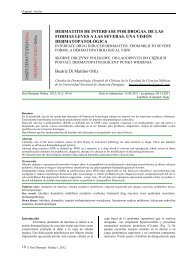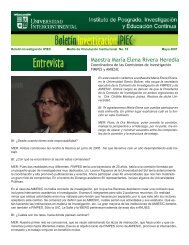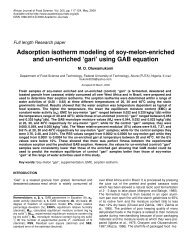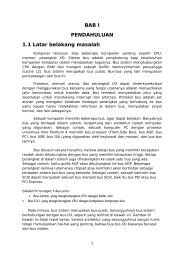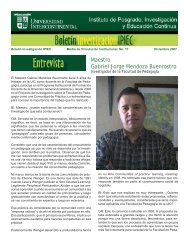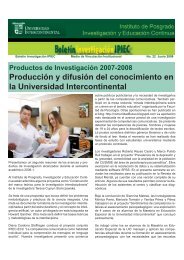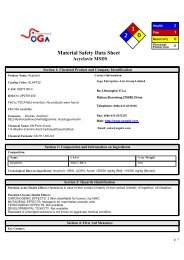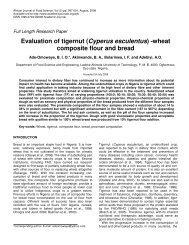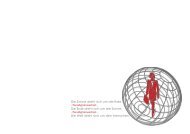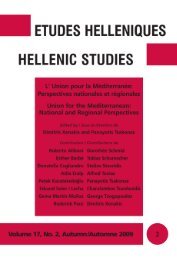Antimicrobial screening of stem bark extracts of ... - Science Stage
Antimicrobial screening of stem bark extracts of ... - Science Stage
Antimicrobial screening of stem bark extracts of ... - Science Stage
Create successful ePaper yourself
Turn your PDF publications into a flip-book with our unique Google optimized e-Paper software.
African Journal <strong>of</strong> Pharmacy and Pharmacology Vol. 2(5). pp. 089-094, July, 2008<br />
Available online http://www.academicjournals.org/ajpp<br />
ISSN 1996-0816 ©2008 Academic Journals<br />
Full Length Research Paper<br />
<strong>Antimicrobial</strong> <strong>screening</strong> <strong>of</strong> <strong>stem</strong> <strong>bark</strong> <strong>extracts</strong> <strong>of</strong><br />
Vitellaria paradoxa against some enteric pathogenic<br />
microorganisms<br />
El-Mahmood, A. M*, Doughari, J. H. and Ladan, N<br />
Department <strong>of</strong> Microbiology, School <strong>of</strong> Pure and Applied <strong>Science</strong>s, Federal University <strong>of</strong> Technology; P.M.B 2076, Yola<br />
640002 Adamawa State, Nigeria.<br />
Accepted June 27, 2008<br />
Preliminary phytochemical <strong>screening</strong> <strong>of</strong> the <strong>stem</strong> <strong>bark</strong> <strong>extracts</strong> <strong>of</strong> Vitellaria paradoxa revealed the<br />
presence <strong>of</strong> carbohydrates, alkaloids, saponins, tannins and cardiac glycosides. Ethanol, acetone and<br />
aqueous <strong>extracts</strong> <strong>of</strong> the plant inhibited the growth <strong>of</strong> pathogenic Escherichia coli, Klebsiella pneumonia,<br />
Proteus mirabilis, Shigella dysenterie and Salmonella typhi with varying degrees <strong>of</strong> activity with the<br />
ethanol <strong>extracts</strong> demonstrating the highest activity against all the test organisms. The activity <strong>of</strong> the<br />
<strong>extracts</strong> increased as the pH was adjusted towards alkalinity, but no significant increase was observed<br />
with increase in temperature. The MBC and MIC values ranged between 6.5-200 mg/ml and to some<br />
extent comparable to those <strong>of</strong> the conventional antibiotic chloramphenicol (6.5 mg/ml). There is<br />
scientific basis for the use <strong>of</strong> this plant as a traditional medicine and can therefore be used to source<br />
new antibiotic substances for the treatment <strong>of</strong> various enteric infections.<br />
Key words: antibiotic, enteric infections, <strong>extracts</strong>, MBC, MIC, pathogenic, phytochemical <strong>screening</strong>, Vitellaria<br />
paradoxa.<br />
INTRODUCTION<br />
Enteric bacteria are a huge heterogeneous group <strong>of</strong><br />
gram-negative rod-shaped bacteria inhabiting the intestinal<br />
tract <strong>of</strong> humans and animals. This group <strong>of</strong> organisms<br />
causes various intestinal and extra-intestinal diseases<br />
though some are only commensals. Strains causing<br />
infections harbor numerous virulence factors encoded on<br />
plasmids, bacteriophages or the bacterial chromosomes<br />
within pathogenicity islands (Nester et al., 1998). <strong>Antimicrobial</strong><br />
resistance among enteric pathogens is becoming<br />
a matter <strong>of</strong> serious concern. This is because antimicrobial<br />
resistance leads to therapeutic failures <strong>of</strong> empirical therapy<br />
(Parekh and Chanda, 2007), thus, the need for<br />
search <strong>of</strong> novel antibiotics to which these groups <strong>of</strong> organisms<br />
are yet to develop resistance. It is against this<br />
background that we thought it was <strong>of</strong> interest to study the<br />
efficacy <strong>of</strong> the Vitellaria paradoxa leaves and <strong>stem</strong> back<br />
against some pathogenic enteric bacteria.<br />
V. paradoxa (formaly Butryspermum paradoxum), (Sa-<br />
*Corresponding author E-mail: elmahmu@yahoo.com.<br />
potaceae) is an immensely popular tree with many applications<br />
in folkloric medicine. It is commonly called Shea<br />
butter (English), Kareje (Fulfulde, Nigeria), Kadanya<br />
(Hausa, Nigeria) Koita (Gbagi, Nigeria), Mmameng<br />
(Cham, Nigeria). The tree grows naturally in the wild <strong>of</strong><br />
the dry savanna belt <strong>of</strong> West Africa, from Senegal in the<br />
West to Sudan in the East and onto the foothills <strong>of</strong> the<br />
Ethiopian mountains. V. paradoxa is considered a sacred<br />
tree by many communities and ethnic groups and plays<br />
important roles in religious and cultural ceremonies. It is<br />
also believed to have some spiritual protective powers<br />
(Pretarious and Watt, 2001; Agbahungba and Depommier,<br />
1989). Different parts <strong>of</strong> the plant including leaves,<br />
roots, seeds, fruit and <strong>stem</strong> <strong>bark</strong> have been used in the<br />
treatment <strong>of</strong> enteric infections such as diarrhea, dysentery,<br />
helminthes and other gastrointestinal tract infections,<br />
skin diseases and wound infections (Soladoye et<br />
al., 1989). The <strong>bark</strong> is used to suppress cough and also<br />
to treat leprosy (Ferry et al., 1974). It is rich in oil and<br />
together with the oil palm serve as sources <strong>of</strong> edible oil<br />
for many households in many parts <strong>of</strong> the Sahel Africa,<br />
particularly Northern Nigeria (Ndukwe et al., 2007). Fat
090 Afr. J. Pharm. Pharmacol.<br />
<strong>extracts</strong> from the kernel <strong>of</strong> the plant is used extensively in<br />
cosmetics and chocolate industries (Nester et al., 1998;<br />
Parekh and Chanda, 2007; Pretarious and Watt, 2001;<br />
Agbahungba and Depommier, 1989; Soladoye et al.,<br />
1989; Dalziel, 1937; Ferry et al., 1974; Ndukwe et al.,<br />
2007; Ndukwe et al., 2007). There are however, few<br />
reports in the scientific literature concerning the antimicrobial<br />
properties <strong>of</strong> this plant. The work was therefore<br />
designed to investigate the antibacterial activity <strong>of</strong> <strong>stem</strong><br />
<strong>bark</strong> <strong>extracts</strong> <strong>of</strong> V. paradoxa and to determine the<br />
phytocostituents present in the plant <strong>extracts</strong>.<br />
MATERIALS AND METHOD<br />
Plant materials<br />
The <strong>stem</strong><strong>bark</strong> <strong>of</strong> V. paradoxa were collected from Sangere village<br />
<strong>of</strong> Girei, Girei Local Government Area, Adamawa State, Nigeria.<br />
The taxonomic identity <strong>of</strong> the plant was confirmed by Mr Bristone<br />
Basiri <strong>of</strong> the Department <strong>of</strong> Biological <strong>Science</strong>s, School <strong>of</strong> Pure and<br />
Applied <strong>Science</strong>s, Federal University <strong>of</strong> Technology, Yola. The<br />
plant parts were air-dried under shade to constant weight for 7-14<br />
days and the dried materials were reduced to powdered form using<br />
a pestle and mortar and then micronized using an electric blender<br />
(Kenwood). The powders were stored in airtight bottles until<br />
required.<br />
Extraction and determination <strong>of</strong> phytoconstituents<br />
Ten grammes (10.0 g) <strong>of</strong> the powdered plant material was soaked<br />
in 100 ml each <strong>of</strong> distilled water, 95% ethanol and acetone in<br />
separate 500 ml sterile conical flasks at room temperature with<br />
uniform shaking in a shaker water bath for 48 h. The content was<br />
then filtered with a muslin cloth and then Whatman No. 1 filter<br />
paper. The filtrates were evaporated to dryness and then packed in<br />
separate clean dry bottles and stored at room temperature until<br />
required. The <strong>extracts</strong> were screened for the presence <strong>of</strong> carbohydrates,<br />
tannins, alkaloids, saponins, phenolics, anthraquinones<br />
and cardiac glycosides as described by Trease and Evans, (1996)<br />
and Parekh and Chanda (2007).<br />
Test Organisms<br />
Eschericia coli, Klebsiella pneumonia, Proteus mirabilis, Shigella<br />
dysenterie and Salmonella typhi were collected in peptone water<br />
with the help <strong>of</strong> the laboratory staff from the Microbiology<br />
Laboratory <strong>of</strong> Specialist Hospital (750 bed capacity) Yola, Nigeria.<br />
Preliminary identification <strong>of</strong> the test organisms were carried out in<br />
the hospital laboratory. Biochemical tests to confirm the identity <strong>of</strong><br />
the organisms were carried out at the Microbiology Laboratory,<br />
Department <strong>of</strong> Microbiology, Federal University <strong>of</strong> Technology,<br />
Yola, Nigeria (Cheesbrough, 2002). The organisms were stored on<br />
Nutrient agar slants in a refrigerator (2-8 o C). Purity <strong>of</strong> the cultures<br />
was checked at regular intervals as described by Acheampong et<br />
al. (1988).<br />
Determination <strong>of</strong> antimicrobial activity <strong>of</strong> <strong>extracts</strong><br />
The agar well dilution method as described by Lino and Deogracious<br />
(2006) was used for this purpose. Standardized inoculum (0.5<br />
McFarland turbidity standard equivalent to 5 x 10 8 cfu/ml) NCCLS,<br />
1990) <strong>of</strong> each test bacterium was spread onto sterile nutrient agar<br />
plates so as to achieve even growth. The plates were allowed to dry<br />
and a sterile cork borer (6.0 mm diameter) was used to bore wells<br />
in the agar plates. The <strong>extracts</strong> were prepared to achieve different<br />
concentrations <strong>of</strong> 10, 20, 30, 40, and 50 mg/ml by redissolving in<br />
20% dimethylsulphoxide (DMSO). Subsequently, 0.5 ml <strong>of</strong> each<br />
concentration <strong>of</strong> the <strong>extracts</strong> was introduced in triplicate wells<br />
earlier bored in the nutrient agar plate cultures. Chloramphenicol<br />
(10 mg/ml) (Joabez Corporation) was used as a positive control and<br />
20% nutrient agar as negative control. The plates were then<br />
incubated at 37 o C for 24 h. <strong>Antimicrobial</strong> activity <strong>of</strong> the <strong>extracts</strong> was<br />
determined after incubation period by measurement <strong>of</strong> zones <strong>of</strong><br />
inhibition produced against the test bacteria.<br />
Effect <strong>of</strong> temperature and pH on activity<br />
This was carried out as described by Emeruwa (1982). Briefly 2.0 g<br />
<strong>of</strong> the sample powder was dissolved in 5 ml <strong>of</strong> distilled water in a<br />
test tube and the contents filtered. 1 ml each <strong>of</strong> the filtrate was<br />
pipetted into two separate test tubes. To the first test tube few<br />
drops <strong>of</strong> 1N HCl was added dropwisely until pH 3 was attained, and<br />
to the second test tube few drops <strong>of</strong> 1N NaOH was also added<br />
dropwislely until pH 10 was attained. All the <strong>extracts</strong> were allowed<br />
to soak for 30 min after which they were neutralized (pH 7) once<br />
again using the appropriate solvents. Another test tube containing<br />
<strong>extracts</strong> only (untreated) was left for the same period (30 min) to<br />
serve as control. <strong>Antimicrobial</strong> activity <strong>of</strong> both the treated and<br />
untreated <strong>extracts</strong> were then determined as earlier described.<br />
For the effect <strong>of</strong> temperature on antimicrobial activity, 2.0 g each<br />
<strong>of</strong> powdered plant <strong>extracts</strong> was dissolved in 6 ml <strong>of</strong> distilled water<br />
and filtered. 2 ml <strong>of</strong> the filtrate was pipetted into two different test<br />
tubes. Each <strong>of</strong> the test tubes were then treated at 4 o C (in the<br />
refrigerator) 60 o C and 100 o C for 30 min respectively using a shaker<br />
water bath. Another test tube containing the <strong>extracts</strong> was left at<br />
room temperature (untreated) for 30 min (control). After heat<br />
treatment, antimicrobial susceptibility <strong>of</strong> both the treated and<br />
untreated <strong>extracts</strong> was carried out against the test bacteria as<br />
earlier described.<br />
Determination <strong>of</strong> minimum inhibitory concentration MIC) and<br />
minimum bactericidal concentration (MBC)<br />
The MIC <strong>of</strong> the <strong>extracts</strong> against the test organisms was determined<br />
using the broth dilution method (Sahm and Washington, 1990).<br />
Briefly, 1.0 ml <strong>of</strong> the extract solution at concentration <strong>of</strong> 200 mg/ml<br />
was added to 1ml <strong>of</strong> nutrient broth to obtain extract concentrations<br />
<strong>of</strong> 200, 100, 50, 25, 12.5 and 6.25 mg/ml in different test tubes. 1 ml<br />
<strong>of</strong> an 18 h culture adjusted to 0.5 McFarland turbidity standard (1.0<br />
x 10 8 cfu/ml) was inoculated in each test tube. It was then mixed<br />
thoroughly on a vortex mixer. The tubes were incubated at 37 o C for<br />
24 h. The tube with the lowest dilution with no detectable growth<br />
was considered the MIC.<br />
To obtain the MBC, two loopfuls <strong>of</strong> broth culture were taken from<br />
the tubes that showed no growth in the above test tubes used for<br />
the MIC determination and were inoculated on to agar plates. The<br />
plates were incubated at 37 o C for 24 h and observed for possible<br />
growth. Concentrations that did not show any growth after incubation<br />
were regarded as the MBC.<br />
RESULTS<br />
The result <strong>of</strong> phytochemical <strong>screening</strong> <strong>of</strong> the <strong>stem</strong> <strong>bark</strong> <strong>of</strong><br />
V. paradoxa showed the presence <strong>of</strong> saponins, alkaloids<br />
phenolics, tannins, cardiac glycosides and carbohydrates<br />
(Table 1). <strong>Antimicrobial</strong> susceptibility <strong>of</strong> the <strong>extracts</strong> (50<br />
mg/ml) against the test organisms showed that in all the<br />
three solvents used, the ethanol <strong>extracts</strong> demonstrat
El-Mahmood et al. 091<br />
Table 1. Phytochemical Screening <strong>of</strong> crude <strong>stem</strong> <strong>bark</strong> <strong>extracts</strong> <strong>of</strong> Vitellaria paradoxa<br />
Phytoconstituents Ethanol <strong>extracts</strong> Acetone <strong>extracts</strong> Water <strong>extracts</strong><br />
Saponins + + -<br />
Carbohydrates + - -<br />
Alkaloids + + +<br />
Phenolics - - +<br />
Tannins + + -<br />
Cardiac glycoside + - +<br />
Anthraquinones - + -<br />
+ = present; - = absent<br />
Table 2. <strong>Antimicrobial</strong> activity <strong>of</strong> <strong>extracts</strong> <strong>of</strong> Vitellaria paradoxa (ambient temperature)<br />
Organisms Aqueous <strong>extracts</strong> Ethanol <strong>extracts</strong> Acetone <strong>extracts</strong> Chloramphenicol<br />
Klebsiella pneumoniae 5.0 8.0 7.0 18.0<br />
Proteus mirabilis 5.0 7.0 8.0 23.0<br />
Shigella dysenterie 5.0 7.0 7.0 23.0<br />
Eschericia coli 4.0 6.0 7.0 18.0<br />
Salmonella typhi - 8.0 8.0 23.0<br />
= no measureable zone <strong>of</strong> inhibition<br />
Table 3. Effect <strong>of</strong> pH on antimicrobial activity <strong>of</strong> Vitellaria paradoxa <strong>stem</strong> <strong>bark</strong> <strong>extracts</strong> (50 mg/ml)<br />
Organisms Acetone <strong>extracts</strong> Water <strong>extracts</strong> Ethanol <strong>extracts</strong><br />
pH 3 pH 10 pH 3 pH 10 pH 3 pH 10<br />
*Ethanol<br />
Extracts<br />
*Acetone<br />
<strong>extracts</strong><br />
Klebsiella pneumoniae 27.0 25.0 18.0 18.0 27.0 25.0 27.0 27.0<br />
Proteus mirabilis 28.0 25.0 16.0 20.0 26.0 22.0 26.0 28.0<br />
Shigella dysentriae 26.0 24.0 18.0 14.0 27.0 24.0 27.0 26.0<br />
Escherichia coli 27.0 24.0 12.0 8.0 26.0 18.0 26.0 27.0<br />
Salmonella typhi 28.0 25.0 10.0 10.0 27.0 20.0 27.0 28.0<br />
*Untreated extract pH 4.5, **Untreated pH 4.2.<br />
the highest activity followed by the acetone <strong>extracts</strong>.<br />
Water <strong>extracts</strong> demonstrated the least activity against all<br />
the test bacteria. For the effect <strong>of</strong> the <strong>extracts</strong> against the<br />
test bacteria, ethanol <strong>extracts</strong> demonstrated the highest<br />
activity (8.0 mm zone diameter <strong>of</strong> inhibition) against S.<br />
typhi and K. pneumonia and 7.0 mm (zone diameter <strong>of</strong><br />
inhibition) against P. mirabilis and S. dysenterie, while the<br />
least activity (6.0 mm zone diameter <strong>of</strong> inhibition) was<br />
demonstrated against E. coli at 50 mg/ml. For the<br />
acetone <strong>extracts</strong>, the highest activity (8.0 mm zone<br />
diameter <strong>of</strong> inhibition) was demonstrated against P. mirabilis<br />
and S. typhi and 7.0 mm (zone diameter <strong>of</strong> inhibition)<br />
each against K. pneumoniae, S. dysentrie and Es. coli.<br />
For the aqueous <strong>extracts</strong> the most effective concentration<br />
(50 mg/ml) demonstrated the activity <strong>of</strong> 5.0 mm (zone<br />
diameter <strong>of</strong> inhibition) and 4.0 mm (zone diameter <strong>of</strong><br />
inhibition) each against K. pneumoniae, P. mirabilis and<br />
S. dysenterie. The lowest activity (4.0 mm zone diameter<br />
<strong>of</strong> inhibition) was demonstrated against E. coli. There<br />
was no activity against S. typhi (Table 2).<br />
The effect <strong>of</strong> pH and temperature on antimicrobial<br />
activity <strong>of</strong> the plant <strong>extracts</strong> are shown in Table 3 and 4.<br />
Results showed that adjustment <strong>of</strong> pH towards alkalinity<br />
had slight diminishing effect on the activity <strong>of</strong> the <strong>extracts</strong>,<br />
and increased temperature generally enhanced the<br />
activity. For instance, at pH 3, the ethanol <strong>extracts</strong> (50<br />
mg/ml) demonstrated the activity <strong>of</strong> 27.0 mm against K.<br />
pneumonia, S. dysenterie, and S. typhi, and 26.0 mm<br />
(zone diameter <strong>of</strong> inhibition) against P. mirabilis and E.<br />
coli. But at pH 10, the activities reduced to 25 (K. pneumonia),<br />
24 (S. dysenterie), 22 (P. mirabilis), 20 (S. typhi)<br />
and 18 mm (E. coli) zone diameters <strong>of</strong> inhibition (Table<br />
3).<br />
For the effect <strong>of</strong> temperature, at 4 and 30 o C<br />
(untreated), the activity <strong>of</strong> the <strong>extracts</strong> was not affected<br />
with the ethanol <strong>extracts</strong> demonstrating the activity <strong>of</strong> 9.0
092 Afr. J. Pharm. Pharmacol.<br />
Table 4. Effect <strong>of</strong> temperature (°C) on antimicrobial activity <strong>of</strong> the <strong>extracts</strong> (50 mg/ml) <strong>of</strong> Vitellaria paradoxa<br />
Organisms<br />
Acetone <strong>extracts</strong> Water <strong>extracts</strong> Ethanol <strong>extracts</strong><br />
4 60 100 4 60 100 4 60 100<br />
*Ethanol<br />
Extracts<br />
*Acetone<br />
<strong>extracts</strong><br />
Klebsiella pneumoniae 7.0 10.0 12.0 7.0 7.0 10.0 8.0 10.0 12.0 8.0 7.0<br />
Proteus mirabilis 8.0 10.0 12.0 8.0 7.0 13.0 9.0 10.0 12.0 9.0 8.0<br />
Shigella dysentriae 8.0 10.0 12.0 7.0 7.0 10.0 9.0 10.0 10.0 9.0 8.0<br />
Escherichia coli 8.0 9.0 12.0 8.0 10.0 13.0 9.0 9.0 10.0 9.0 8.0<br />
Salmonella typhi 8.0 9.0 12.0 8.0 9.0 13.0 8.0 10.0 10.0 8.0 8.0<br />
*Untreated extract (ambient temperature 30°C)<br />
Table 5. Minimum inhibitory concentration (MIC) values <strong>of</strong> the <strong>stem</strong> <strong>bark</strong> extract <strong>of</strong> Vitellaria paradoxa<br />
Organisms<br />
MIC (mg/ml)<br />
Aqueous Ethanol Acetone<br />
200 100 50 25 12.5 6.5 200 100 50 25 12.5 6.5 200 100 50 25 12.5 6.5<br />
Escherichia coli + + - + + + + + - - - + - - - + + +<br />
Klebsiella pneumoniae + + + + + + + - - - - - - - - + + +<br />
Proteus mirabilis + + - - + + + + - - + + + - - + + +<br />
Shigella dysentriae + + - + + + - - - - + - - - - + - +<br />
Salmonella typhi + + - - + + + - - - - + + - - + + +<br />
Chloramphenicol - - - - -<br />
+ = presence <strong>of</strong> bacterial growth; - + = absence <strong>of</strong> bacterial growth<br />
Table 6. Minimum bactericidal concentration (MBC) values <strong>of</strong> the <strong>stem</strong> <strong>bark</strong> extract <strong>of</strong> Vitellaria paradoxa<br />
Organisms<br />
MBC (mg/ml)<br />
Aqueous Ethanol Acetone<br />
200 100 50 25 12.5 6.5 200 100 50 25 12.5 6.5 200 100 50 25 12.5 6.5<br />
Escherichia coli + + - - + + + + - - - - - - - + + +<br />
Klebsiella pneumoniae + + + - + + + - - - + + - - - + + +<br />
Proteus mirabilis + + - - + + + + - - - - + - - - + +<br />
Shigella dysentriae + + - - + + - - - - + - - - - + + +<br />
Salmonella typhi + + - - + + + - - - + - + - - - + +<br />
Chloramphenicol - - - - + -<br />
+ = presence <strong>of</strong> bacterial growth; - + = absence <strong>of</strong> bacterial growth.<br />
mm (zone diameter <strong>of</strong> inhibition) each against E. coli, S.<br />
dysenterie and, P. mirabilis; and 8.0 mm (zone diameter<br />
<strong>of</strong> inhibition) against K. pneumonia, but as the temperature<br />
was raised to 60 o C there was no significant change<br />
in activity (10.0 mm zone diameter <strong>of</strong> inhibition each)<br />
against all the test organisms. A similar trend was<br />
observed with the <strong>extracts</strong> <strong>of</strong> all the other solvents (Table<br />
4).<br />
The MIC and MBC values <strong>of</strong> the <strong>extracts</strong> against the<br />
test organisms ranged between 25-200 mg/ml for the<br />
water <strong>extracts</strong> and acetone <strong>extracts</strong> and 6.5 - 200 mg/ml<br />
for the ethanol <strong>extracts</strong> (Table 5 and 6). These values<br />
were to some extend comparable to those <strong>of</strong> chloramphenicol<br />
even though the antibiotic is in a pure state.<br />
DISCUSSION<br />
Preliminary phytochemical investigations <strong>of</strong> the <strong>stem</strong> <strong>bark</strong><br />
and leaves <strong>of</strong> V. paradoxa revealed the presence <strong>of</strong><br />
some phytochemical compounds. Phytoconstituents<br />
(alkaloids) has earlier been reported in different plants<br />
including the <strong>stem</strong> <strong>bark</strong> <strong>of</strong> Setigera and Nauclea latifolia<br />
(El-kheir and Salim, 1980; Tona et al., 1998). These<br />
secondary metabolites are linked to antimicrobial activity<br />
<strong>of</strong> the plant material. Drugs contained in medicinal plants<br />
are called active principles and these active principles are<br />
divided into a number <strong>of</strong> groups. Carbohydrates present<br />
in plants are mostly in the form <strong>of</strong> pentoses, sucrose and<br />
soluble sugars which are intermediate plant constituents
El-Mahmood et al. 093<br />
and whose pharmacognostic significance <strong>stem</strong> from the<br />
fact that they combine with a numerous variety <strong>of</strong> compounds<br />
to form glycosides. The presence <strong>of</strong> glycoside<br />
moieties like saponins, anthracene and cardiac glycolsides,<br />
some <strong>of</strong> which are known to structurally resemble<br />
sex hormones (oestrogens, gestrogens and androgens)<br />
are known to protect against gastric infections caused by<br />
enteric pathogens thus justifying the use <strong>of</strong> this plant in<br />
traditional medicine practice. All the <strong>extracts</strong> from the<br />
different solvents demonstrated antimicrobial activity with<br />
the ethanol <strong>extracts</strong> demonstrating the highest activity.<br />
Variation in activity among different extracting solvents<br />
has earlier been reported (Falodun et al., 2006). Differences<br />
in polarity among various solvents have been<br />
reported to be accountable for the differences in solubility<br />
<strong>of</strong> plant active principles, hence variation in degree <strong>of</strong><br />
activity. The water <strong>extracts</strong> however, demonstrated the<br />
least activity against all the test bacteria. When plant<br />
materials are grounded in water or the plant cells are<br />
damaged, some phenolases and hydrolases are <strong>of</strong>ten<br />
released and these enzymes might have modulatory<br />
effect on the activity <strong>of</strong> the active compounds in the<br />
extract or there may incomplete extraction <strong>of</strong> the active<br />
principles thus explaining the low activity. Traditionally,<br />
however crude plant <strong>extracts</strong> are prepared with water as<br />
infusions, decoctions and poultices, therefore it is very<br />
unlikely that the herbalist is able to extract all these<br />
compounds, which are responsible for the activity<br />
observed in acetone and ethanol <strong>extracts</strong>. Generally,<br />
acetone and ethanol showed broader and greater spectra<br />
<strong>of</strong> activity against the tested organisms.<br />
Results also showed that activity <strong>of</strong> all the <strong>extracts</strong><br />
were concentration dependent. Similar results have been<br />
reported by several researchers. Highest activity was<br />
demonstrated by the standard antibiotic chloramphenicol<br />
(control). This is because the antibiotic is in pure state<br />
and has refined processes that have established it as a<br />
standard antibiotic (Prescott et al., 2002).<br />
The organisms used for the purpose <strong>of</strong> this investigation<br />
are associated with various forms <strong>of</strong> infections; S.<br />
dysentriae (dysentery), K. pneumoniae (pneumonia), P.<br />
mirabilis (wound infections), E. coli (gastrointestinal tract<br />
infections) and S. typhi (typhoid fever) (Prescott et al.<br />
2002). Results <strong>of</strong> this investigation therefore have shown<br />
that V. paradoxa is a potential source <strong>of</strong> antibiotic substances<br />
for drug development for use against this group<br />
<strong>of</strong> enteric organisms. In earlier works however, K. pneumoniae<br />
was observed to be resistant to the aqueous,<br />
methanol and acetone <strong>bark</strong> <strong>extracts</strong> <strong>of</strong> eight plants used<br />
for traditional medicine in Paraguay. In this investigation<br />
however, ethanol and acetone <strong>bark</strong> <strong>extracts</strong> inhibited the<br />
growth <strong>of</strong> K. pneumoniae significantly. The ethanol<br />
<strong>extracts</strong> <strong>of</strong> the <strong>stem</strong><strong>bark</strong> was previously found to inhibit<br />
the growth <strong>of</strong> E. coli and P. mirabilis (Legrand et al.,<br />
1988).<br />
Acid and alkaline treatment was carried out in order to<br />
slightly simulate the stomach and duodenal conditions and<br />
also to predict the condition under which the drug would<br />
be more effective, if it is to be formulated for com-mercial<br />
purposes and since the plant is also used in the<br />
treatment <strong>of</strong> constipation and diarrhea traditionally. As<br />
the temperature <strong>of</strong> the <strong>extracts</strong> was increased, their activity<br />
also gradually increased. It is assumed that the<br />
increase in temperature increases the activity <strong>of</strong> the<br />
bioactive components <strong>of</strong> the <strong>extracts</strong> probably due to<br />
increased solubility. This explains why traditionally, the<br />
<strong>extracts</strong> are still effective in remedying the ailment they<br />
are being used to against; besides the <strong>extracts</strong> are taken<br />
while still warm ensuring effectivity and consequently<br />
their continued usage in traditional medicine.<br />
Demonstration <strong>of</strong> low MIC and MBC values by especially<br />
the ethanol <strong>extracts</strong> is an indication that the phytoconstituents<br />
<strong>of</strong> the plant have therapeutic properties and<br />
therefore justifies its traditional medicinal uses.<br />
Conclusion<br />
Results from this study showed the therapeutic activity <strong>of</strong><br />
V. paradoxa against some selected members <strong>of</strong> the<br />
enterobacteriaceae. The plant can therefore be used to<br />
manage enteric infections like diarrheal diseases. Toxicological<br />
studies, purification and identification <strong>of</strong> the plant<br />
active principles should be em<strong>bark</strong>ed upon in addition to<br />
investigating its activity on a wider range <strong>of</strong> bacteria and<br />
fungi.<br />
REFERENCES<br />
Acheampong YB, El-Mahmood MA, Olurinola PF (1988). The<br />
Antibacterial properties <strong>of</strong> the liquid Antiseptic TCP. Indian J. Pharm.<br />
Sci. (3): 183-186.<br />
Agbahungba G, Depommier D (1989). World Oil Seeds Chemistry,<br />
Technology and Utilization. Van Nostraud Rein Hold, New York. p.<br />
554.<br />
Cheesbrough M (2002). District Laboratory Practice in Tropical<br />
Countries Part II; Cambridge University Press UK. pp.136-142.<br />
Dalziel JM (1937). Useful Plants <strong>of</strong> West Africa. Crown Agents London,<br />
p. 612.<br />
El-khier JM, Salim MH (1980). Investigation <strong>of</strong> certain plants used in<br />
Sudanese folk medicine Fitoterapia. 51: 143-147.<br />
Emeruwa KC (1982). <strong>Antimicrobial</strong> Substances from Carica papaya<br />
FruitExtracts. J. Nat. Products. 45(2): 125-127.<br />
Ell<strong>of</strong> JN (1998). Which extract should be used for the <strong>screening</strong> and<br />
isolation <strong>of</strong> antimicrobial components from plants<br />
Ethnopharmacology. 60: 1-8.<br />
Falodun A, Okunrobo LO, Uzoamaka N (2006). Phytochemical<br />
<strong>screening</strong> and anti-inflammatory evaluation <strong>of</strong> methanolic and<br />
aqueous <strong>extracts</strong> <strong>of</strong> Euphorbia heterophylla Linn (Euphorbiaceae).<br />
Afr. J. Biotechnol. 5(6): 529-531.<br />
Ferry MP, Gessain M, Geeain R (1974) Vegetative Propagation <strong>of</strong><br />
Shea, Kola and Pentadesma. Cocoa research institute, Ghana<br />
Annual Report (1987/88): 98-100.<br />
Latha SP, Kannabiran K (2006). <strong>Antimicrobial</strong> Activity and<br />
Phytochemical <strong>of</strong> Solanum trinobatum Linn. Afr. J. Biotechnol. 5(23):<br />
2402-2404.<br />
Legrand A, Wandergema PA, Verpwites R, Pousset JL (1985).<br />
Antinfectious Phytotherapies <strong>of</strong> the tree Savanna <strong>of</strong> Senegal (West<br />
Africa) II. <strong>Antimicrobial</strong> Activity <strong>of</strong> 33 species. J. Enthnopharmacol.<br />
1: 25-31.<br />
Lino A, Deogracious O (2006). The In vitro Antibacterial Activity <strong>of</strong><br />
Annona senegalensis, Securidacca longipendiculata and<br />
Steganotaenia araliacea – Ugandan Medicinal Plants. Afr. Health
094 Afr. J. Pharm. Pharmacol<br />
Sci. 6(1): 31-35.<br />
National Committee for Clinical Laboratory Standard (NCCLS) (1990).<br />
Performance Standard Stand for <strong>Antimicrobial</strong> Susceptibility test<br />
approval standard M 2 – A 4 (NCCLS) Villanova. PA.<br />
Ndukwe IG, Amupitan JO, Isah Y, Adegoke KS (2007). Phytochemical<br />
and antimicrobial <strong>screening</strong> <strong>of</strong> the crude <strong>extracts</strong> from the root,<br />
<strong>stem</strong><strong>bark</strong> and leaves <strong>of</strong> Vitellaria paradoxa (GAERTN. F). Afr. J.<br />
Biotechnol. 6 (16): 1905-1909.<br />
Nester EW, Robert CE, Pearsal NN, Anderson DG, Nester MT (1998).<br />
Microbiology: A Human Perspective 2 nd Edition. McGraw Hill Inc. pp.<br />
401-700.<br />
Parekh J, Chanda S (2007). In vitro antimicrobial activity <strong>of</strong> Trapa<br />
natans L fruit rind extracted in different solvents. Afr. J. Biotechnol.<br />
6 (16): 1905-1909.<br />
Pretaorius CJ, Watt E (2001) Purification and Identification <strong>of</strong> Active<br />
components <strong>of</strong> Carpobrotus edullis L. J. Enthnopharma 76: 87-91.<br />
Prescott ML, Harley PJ, Klein AD (2002). Microbiology, 5 th Edition,<br />
McGraw Hill Inc. p. 39.<br />
Sahm D, Washington F (1990). <strong>Antimicrobial</strong> Susceptibility Test Dilution<br />
Method, In: Manuals <strong>of</strong> Clinical Microbiology, Lennette E.H 5 th<br />
edition, America Society <strong>of</strong> Microbiology, Washington DC, pp. 1105-<br />
1116.<br />
Soladoye MO, Orhiere SS, Ibimode BM (1989). Ethanobotanical Study<br />
<strong>of</strong> two Indigenous Multipurpose Plants in the Guinea Savanna <strong>of</strong><br />
Kwara State - Vitellaria paradoxa and Parkia biglobosa Biennial<br />
Conference <strong>of</strong> Ecological Society <strong>of</strong> Nigeria, 14 August, 1989,<br />
Forestry Research Institute, Ibadan. p.13.<br />
Treese GE, Evans WC (1996) Pharmacognosy, Bailliere Tridall,<br />
London. pp. 89-122.<br />
Tona LK, Ngimbi N, Cimanga K, Vlitink AJ (1998). Antiamoebic and<br />
Phytochemical Screening <strong>of</strong> Some Conaplese Medicinal Plants. J.<br />
Ethnorpharm. 10(4): 55-61.<br />
Parekh J, Chanda S (2007). In vitro antimicrobial activity <strong>of</strong> Trapa<br />
natans L fruit rind extracted in different solvents. Afr. J. Biotechnol.<br />
6 (16): 1905-1909.<br />
Pretaorius CJ, Watt E (2001) Purification and Identification <strong>of</strong> Active<br />
components <strong>of</strong> Carpobrotus edullis L. J. Enthnopharma 76: 87-91.<br />
Prescott ML, Harley PJ, Klein AD (2002). Microbiology, 5 th Edition,<br />
McGraw Hill Inc. p. 39.<br />
Sahm D, Washington F (1990). <strong>Antimicrobial</strong> Susceptibility Test Dilution<br />
Method, In: Manuals <strong>of</strong> Clinical Microbiology, Lennette E.H 5 th<br />
edition, America Society <strong>of</strong> Microbiology, Washington DC, pp. 1105-<br />
1116.<br />
Soladoye MO, Orhiere SS, Ibimode BM (1989). Ethanobotanical Study<br />
<strong>of</strong> two Indigenous Multipurpose Plants in the Guinea Savanna <strong>of</strong><br />
Kwara State - Vitellaria paradoxa and Parkia biglobosa Biennial<br />
Conference <strong>of</strong> Ecological Society <strong>of</strong> Nigeria, 14 August, 1989,<br />
Forestry Research Institute, Ibadan. p.13.<br />
Treese GE, Evans WC (1996) Pharmacognosy, Bailliere Tridall,<br />
London. pp. 89-122.<br />
Tona LK, Ngimbi N, Cimanga K, Vlitink AJ (1998). Antiamoebic and<br />
Phytochemical Screening <strong>of</strong> Some Conaplese Medicinal Plants. J.<br />
Ethnorpharm 10(4): 55-61.



